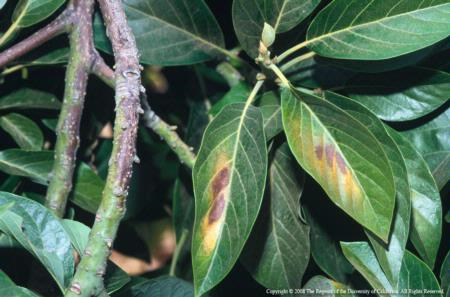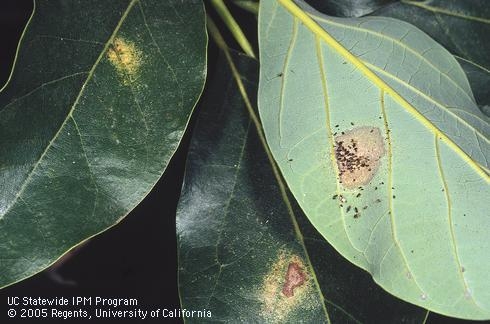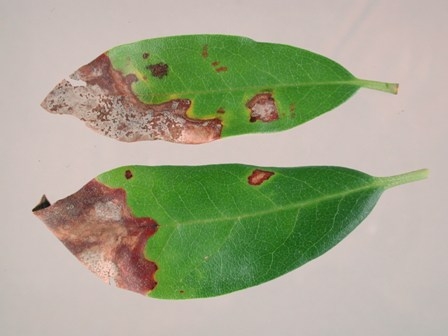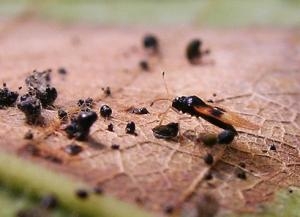
Posts Tagged: Dothiorella
When It Gets Hot, It Gets Confusing
So I got called out to see an orchard that had dieback. Over the phone it sounded like “Dothiorella Leaf Blight” (//ucanr.edu/blogs/blogcore/postdetail.cfm?postnum=10354). This symptom shows up when there has been water stress of some sort, over a period of a few weeks to months. 
It can be a branch or a whole tree. It usually is due to a watering schedule that doesn't meet the needs of the plant. It is exacerbated by competition from more aggressive plants nearby, like eucalyptus windbreaks. With increased competition over time, root rot can also start taking its toll because of the stress, as well. Where you see areas cleared of trees, and where there are struggling trees in various stages of survival, it's a good indication of a rough environment.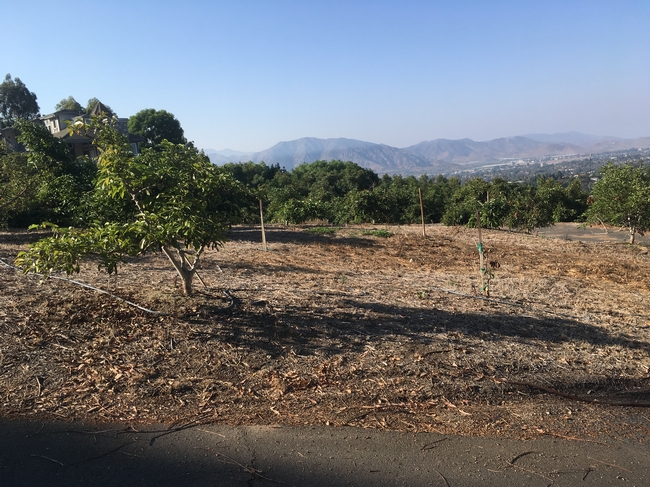
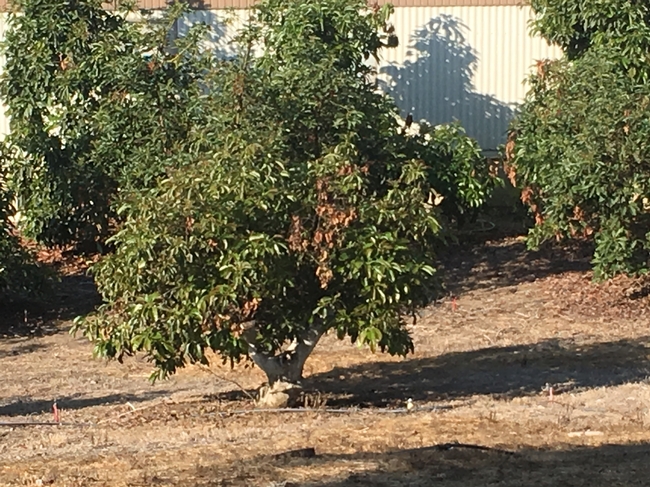
Trees with root rot symptoms may have been stumped previously, and with their weakened root systems are more prone to leaf blight.
In the case of this grove, it was at the top of the hill where it got all the wind and a full day's sun above the typical coastal fog.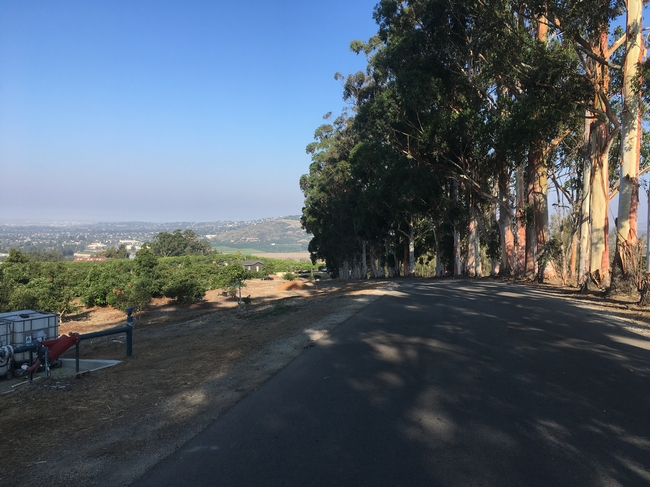
So the grower asked about the damage. There was the heat damage from the July heat wave.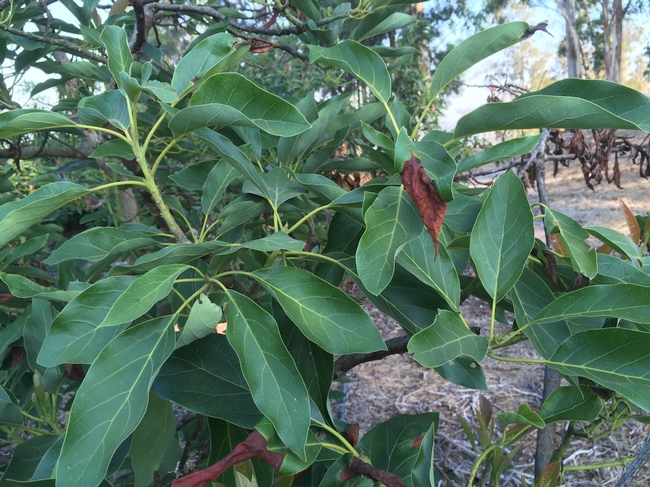
Then there was the damage that had showed up earlier, the leaf blight that was associated with the ongoing water stress. In a way, both of these symptoms are of water stress, one very rapid, hence the reddish tint to the leaves. The other a slower collapse, the leaf blight from prolonged water stress.
Over time, this type of stress had allowed root rot to take hold and trees were stumped in order to help them survive. The trees were also started on a regular phosphonate program. In general, the rest of the orchard looked good, except for this area near the competitive windbreak trees. The heat damage was mostly in this area, as well. The grower had been forewarned of the impending heat and irrigated the trees prior to the hard weather.
In the case of heat damage or blight, and leaf/stem blight, it's not fatal for mature trees. Younger trees under two years can be killed. They usually need whitewashing to prevent sun burn damage.
But even they can be revived if the watering is improved.
Avocado Lace Bug - ALB - Is Near You?
On October 5, 2017, the California Avocado Commission (CAC) was alerted to a possible infestation of avocado lace bug (ALB; Pseudacysta perseae) in commercial avocado groves in Oceanside and De Luz, San Diego County. UCR's Mark Hoddle confirmed the infestation. During his survey, Hoddle found all life stages of ALB in groves in both locations, indicating a well-established, reproducing population.
Avocado Lace Bugs are an introduced (who did it?) pest that was found in San Diego in 2004. Previously in the US, it had only been found in Florida. Their impact of avocados can be minor, or with explosive growth can cause significant defoliation. ALB has been known to be established in southern San Diego County for about 15 years, but only on backyard avocado trees. It appears that this is the first infestation of this pest in commercial groves.
Feeding damage occurs near mid-vein on lower leaf surface and appears as a yellow halo on the upper leaf surface.
Lace bugs restrict their feeding to the undersides of leaves, inserting their needle-like mouthparts into leaf tissue cells to extract cell contents. Feeding initially causes small white or yellow spots on the surface of the leaves as individual cells dry out. It is suspected that feeding damage can provide entrance for pathogenic fungi, in particular Colletotrichum spp., which are leaf anthracnose fungi. As lace bug colonies grow, brown necrotic (dead) areas develop where there has been heavy feeding damage. These necrotic areas look like tip-burn caused by salt damage, but in this case, the necrotic areas are islands of dead tissue in the interior of the leaf surrounded by living tissue. Heavy feeding can cause striking leaf discoloration and early leaf drop.Other signs of lace bugs are dark, varnish-like excrement and shed white nymphal skins on the undersides of leaves. Avocado lace bug nymphs and adults do not feed on fruit
Avocado lace bugs have only been reported feeding on avocado, red bay, and camphor, all members of the Lauraceae family. Experimental evidence from Florida indicates that avocado varieties vary in their susceptibility to feeding damage. West Indian x Guatemalan avocado hybrids appear to be particularly resistant to attack in Florida. Observations in the Dominican Republic indicate that Hass avocados (a Mexican-Guatemalan hybrid) can be severely damaged by lace bug outbreaks with occasional severe infestations causing defoliation and reduced yields.
It's important that we all keep our eyes open for this pest. It can easily be confused with salt burn or leaf blight damage, though. Looking for the insect which can be present all year round, the excrement pellets and the unusual yellow halo feeding symptom on the upper leaf surface are all good indicators that the insect is there. Leaf Blight fungus on the other hand has dead spots that appear on both upper and lower leaf surfaces and have wave effect as the fungus spread beyond the point of origin.
For complete details on identification, life cycle and management, you are encouraged to visit the UC IPM ALB webpage (http://ipm.ucanr.edu/PMG/PESTNOTES/pn74134.html).
Look for adults and excrement pellets
Leaf Blight caused by Botryosphaeria sp.
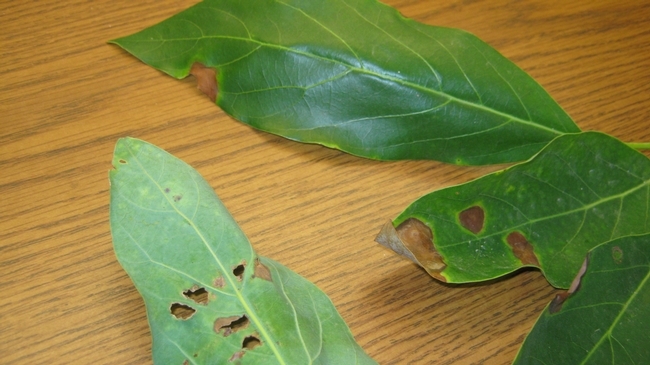
leaf blight damage
Water. Water. Water. And We Still Need to Learn How to Use It Right.
A recent grower survey in Santa Barbara County asked a whole bunch of questions. One of which was had they had an evaluation of irrigation distribution uniformity. This is a free service that can significantly improve on-farm water use and most importantly improve plant health. Avocados that don't get the right amount of water at the right time are extremely susceptible to root rot. Proper irrigation is the first line of defense against root rot, good farming that results in good economic returns to the grower.
So, with a free DU available to growers, how many do you think took advantage of the service? Barely 50%!!!!!!!! This just does not make sense. In a land of little water and frequent examples of what can happen with no water ………………..and high priced water, what is going on?
The local Resource Conservation District has done many system evaluations, and most results find that improvements can be made in distribution uniformity. This is true in relatively new irrigation installations. It does not take long for problems to occur in even well designed and installed systems.
During the summer of 2007, the Casitas Municipal Water District (CMWD) contracted with the Irrigation Training and Research Center (ITRC) of California Polytechnic State University, San Luis Obispo, to conduct field evaluations of drip/micro systems. A team of two students conducted 35 field evaluations.
Distribution Uniformity (DU) – DU is a measure of the uniformity of water application to trees throughout an orchard, with DU = 1.0 being perfect. The measured orchard DUs in the Santa Barbara/Ventura area had an average DU of 0.66, while the California state average for drip/micro is 0.85.
In general, there were substantial opportunities to improve the distribution uniformity (DU) of the water to trees throughout an orchard. An improved DU will minimize over-irrigation in some areas, and reduce under-irrigation in others. Key recommendations that were provided included:
Install a pressure regulator at the head of every hose
With a regular microsprinkler, doubling the pressure causes about 40 percent more water to come out of the nozzle. Pressure regulators are added to have similar pressures throughout the orchard and thus reduce the risk of over-irrigating portions of the field. On many farms, the difference between the highest pressures was double or even triple the lowest pressures (40-70% more water). By adding the correct high-quality, pre-set pressure regulators with the correct flow rate rating, the farmer can get similar pressures to every nozzle and prevent over-irrigation.
For a pressure regulator (PR) to work, more pressure must enter the PR than what the PR is rated for. For example, to use a 25 psi PR, you need at least 27 psi into the PR. All a PR does is reduce pressure; it cannot add pressure.
Another problem on hillsides is that some pipes have as much as 100 psi before the PR. A PR can effectively reduce the pressure down to 50%. What is recommended in these fields is to reduce the pressure in the pipe by adding an in-line valve halfway down the hill and throttling it down to a reasonable pressure.
Completely replace all microsprinkers with pressure compensating microsprinklers
Pressure compensating microsprinklers have an internal flexible diaphragm that reduces a pathway as the pressure increases. These allow similar amounts of water to get the trees even if the hoses do not have the same pressures. Whenever the pressure is doubled, 10 percent more water will come out of these emitters, compared to 40 percent more water with a regular microsprinkler. Having pressure compensating emitters can drastically improve the DU in virtually every avocado orchard because most irrigation systems were not properly designed for microsprinkler systems, or because the farmer has altered the original design by adding different-sized nozzles.
Reduce plugging problems
Major plugging problems are found in all orchards that did not have good filtration, even those that get district water. There were also some “within-system” causes of plugging. Almost all plugging is from simple dirt or rust, as opposed to bacteria or algae. Recommendations are as follows:
- Always have a filter at the head of the system. The required mesh size depends on the microsprinkler flow rate, but 120 mesh is a starting point.
- Remove hose screen washers that are found at the head of hoses, and replace them with regular washers (after installing a filter at the head of the system). The hose screen washers often plug up and cause the hoses to have unequal inlet pressures.
- Be sure to thoroughly flush hoses after any hose breaks.
- Double check the type of fertilizer that is being injected, especially any “organic fertilizers”. Some of these can plug emitters. In any case, inject the fertilizers upstream of the filters. If the filter plugs up, it is better to have discovered the problem early.
- Clean the filters frequently. Install pressure gauges upstream and downstream. When the pressure differential (as compared to a clean screen) increases by 3-5 psi, it's time to clean the screen.
In some orchards, there is a big plugging problem caused by insects crawling into emitters after the water is shut off. Many of the new microsprinkler designs utilize a self-closing mechanism to prevent insects from coming into the nozzle.
We have gotten a reprieve with the rains and refilled reservoirs, but it is ever more important to make sure our irrigation systems are doing what they are supposed to be doing. Call your local Resource Conservation District and get information about a system evaluation. Contact numbers can be found at: http://www.carcd.org/rcd_directory0.aspx
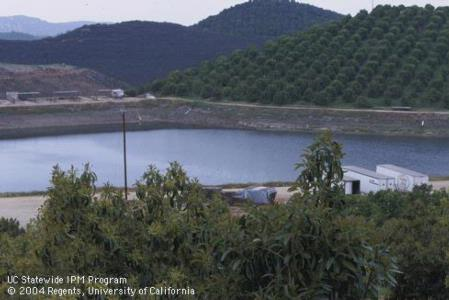
irrigation pond
Avocado Body Rots Are Showing Up Now
Get ready for more rotting avocado fruit if you have leaf blight showing up in your tree canopy. The fungal spores (one of the Botryosphaerias we once lumped as Dothiorella) that create the infection spread in an irregular pattern over the leaf and down the stem (then called “stem blight”). This is often confused with salt or tip burn. The two conditions are caused by the same problem, water and or salt stress. However, in the case of leaf blight, this is a pathogen that can pass to neighboring fruit and begin the process of rot. This starts happening when the fruit starts ripening and softening, so it's often not seen in the orchard, but the packhouse or in the market.
Control is basically gaining control over the soil moisture and salinity in the root zone and when the leaf blight starts showing up in the canopy, cutting as much out back to green tissue as is economically possible.
Leaf blights from this group of fungi have also been reported as infecting other fruits, such as citrus, apple, peach and grape among others. The solution is the same - water right and cut the stuff out when and if it shows up.
Photos:
Body rots
Rot spreading to flesh
Leaf Blight

avocado body rot1

avocado body rot2

Avocado leaf blight
My Trees Look Horrible. Why?
The calls are coming in and have been for the last several months. The trees are tired, worn out and look horrible. What's the problem? Well four years of drought, accumulated salts in the root zone and irrigation practices that aren't removing the salts from the root zone. It sets up a situation of tip burn, but much more extensive than tip burn is the water stress that results from salt accumulation. Salts compete with roots for water and they act to pull water away from the roots. It is as if less water is being applied. The water stress sets up the trees for a fungal infection called variously leaf blight, stem blight and in young trees, death. We used to call this Dothiorella blight, but since the work of Akif Eskalen at UC Riverside, it turns out it is one of many fungi that cause this problem, most of them Botryosphaerias.
The leaves show what would appear to be salt burn damage which increasingly causes leaf drop. In fact, there's often a pile of leaves under the canopy unless the wind has blown them away. The difference between this and salt burn is that there is not a regular pattern to it. It can start on the margins, or in the middle of the leaf, or wherever it darn well pleases. Whereas salt/tip burn always starts at the leaf tip and progressively moves back onto the main part of the leaf. Leaf blight (I don't like to use bigger words than that – Botryosphaeria. Try spelling it on the phone), on the other hand doesn't follow this regular pattern. It's a random pattern.
This a decomposing fungus. Wherever there is organic matter – leaves, twigs, branches, fruit, whatever is dead on the ground – there is a decomposing fungus. When the fungus finds a stressed plant, it invades the most susceptible part of the plant, usually the leaf. It starts growing through the tissue and down the leaf petiole. It then starts growing down the dead part of the plant. Most of a tree is dead. All that stuff under the bark and cambium is dead tissue, although it still carries water. In mature trees, there is a capacity to close off the decay and limit it. In young trees (younger than two or so), the capacity is lacking and the fungus can keep on growing down to the union and kill the tree.
As can be imagined, this fungus does not discriminate amongst the type of plants it feeds on. It will go to water-stressed, citrus, roses, apples, etc. It goes to every woody perennial that I am aware of. I've seen it on redwoods and eucalyptus. It especially goes after shallow-rooted species like avocado which are the most prone to water-stress. Like when a Santa Ana blows in and the irrigation schedule is slow to respond. Like when there is a heavy load of fruit. Fruit have stomata and the more environmental stress the more water they lose and pull on water from the tree.
Now imagine a tree loaded with fruit, in the later summer, with a Santa Ana and salt stress. Boom! Fruit drops and leaf blight shows up. And the damage doesn't go away, until it so severe that the leaf drops and new leaves come on in the spring.
Hopefully these rains will wash the salts from the root systems and refill the profile with high quality water. We are extremely reliant on winter rain to cover up the effects of the damage that irrigation water does to our soil and plants. And rain is the answer, as long as it's not too much.
Notice the even pattern of necrosis with tip burn
And the random pattern with leaf blight.

avocado tip burn 2

avocado leaf blight 3

